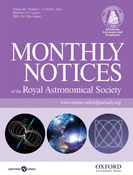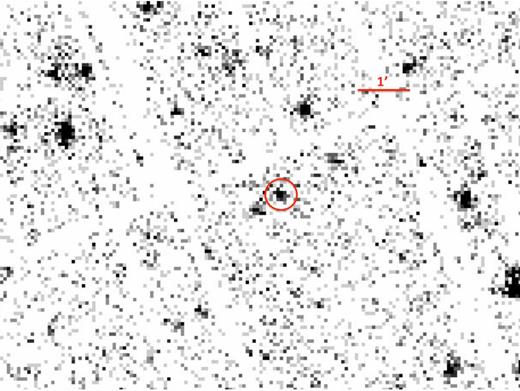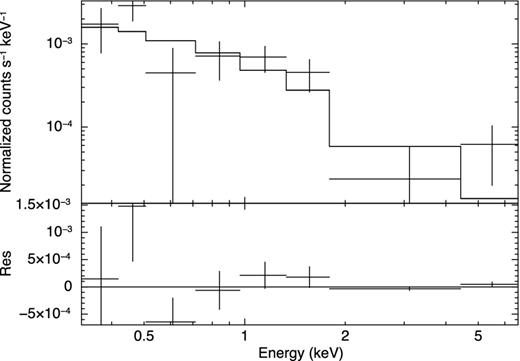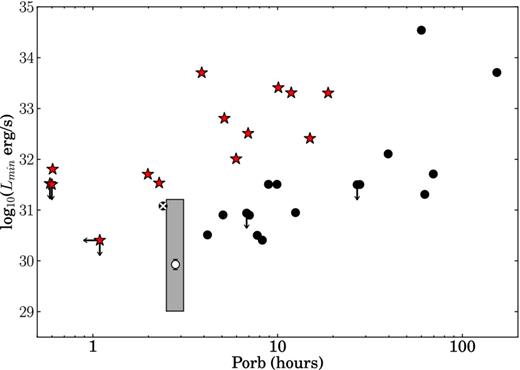-
PDF
- Split View
-
Views
-
Cite
Cite
M. Armas Padilla, R. Wijnands, N. Degenaar, T. Muñoz-Darias, J. Casares, R. P. Fender, Swift J1357.2−0933: the faintest black hole?, Monthly Notices of the Royal Astronomical Society, Volume 444, Issue 1, 11 October 2014, Pages 902–905, https://doi.org/10.1093/mnras/stu1487
Close - Share Icon Share
Abstract
Swift J1357.2−0933 is a confirmed very faint black hole X-ray transient and has a short estimated orbital period of 2.8 h. We observed Swift J1357.2−0933 for ∼50 ks with XMM–Newton in 2013 July during its quiescent state. The source is clearly detected at a 0.5–10 keV unabsorbed flux of ∼3 × 10−15 erg cm−2 s−1. If the source is located at a distance of 1.5 kpc (as suggested in the literature), this would imply a luminosity of ∼8 × 1029 erg s−1, making it the faintest detected quiescent black hole low-mass X-ray binary. This would also imply that there is no indication of a reversal in the quiescence X-ray luminosity versus orbital period diagram down to 2.8 h, as has been predicted theoretically and recently supported by the detection of the 2.4 h orbital period black hole MAXI J1659−152 at a 0.5–10 keV X-ray luminosity of ∼1.2 × 1031 erg s−1. However, there is considerable uncertainty in the distance of Swift J1357.2−0933 and it may be as distant as 6.3 kpc. In this case, its quiescent luminosity would be LX ∼ 1.3 × 1031 erg s−1, i.e. similar to MAXI J1659−152 and hence, it would support the existence of such a bifurcation period. We also detected the source in optical at r′ ∼ 22.3 mag with the Liverpool telescope, simultaneously to our X-ray observation. The X-ray/optical luminosity ratio of Swift J1357.2−0933 agrees with the expected value for a black hole at this range of quiescent X-ray luminosities.
INTRODUCTION
Transient low-mass X-ray binaries (LMXBs) occasionally experience outburst events, caused by a sudden increase in the mass-accretion on to the compact object, a black hole (BH) or a neutron star (NS), with a resultant large increase in the X-ray luminosity. However, most of the time these sources remain in a dim, quiescent state where little or no accretion takes place. Quiescent BH binaries are systematically fainter than NS binaries, especially when comparing systems with similar orbital periods (Narayan, Garcia & McClintock 1997; Kong et al. 2002). While most NS systems in quiescence have 0.5–10 keV luminosities LX > 1031 erg s−1, BH X-ray transients can be as faint as LX ∼ 1030 − 31 erg s−1.
The low quiescent luminosities of BH LMXBs are explained invoking radiation from an advection-dominated accretion flow (ADAF; Narayan et al. 1997; Narayan & McClintock 2008), where most of the accretion energy is eventually advected through the event horizon rather than being radiated away. In NS systems, on the other hand, all the advected energy is expected to be radiated at the NS surface, resulting in a much higher radiative efficiency even if the inner accretion flow is an ADAF. An alternative scenario might be the jet-dominated states in quiescence, in which the majority of the accretion power is released in the form of radio jets rather than dissipated in the accretion flow through X-ray emission (Fender, Gallo & Jonker 2003). The difference in quiescent X-ray luminosity between NSs and BHs is explained by the considerable reduced jet contribution in quiescent NSs with respect to the ‘radio-loud’ BHs (Fender et al. 2003; Gallo et al. 2006, 2007; Migliari et al. 2006; Körding et al. 2007)
Menou et al. (1999) predicted a positive correlation between the orbital period and the quiescent X-ray emission based in the ADAF model. This correlation is expected to break (and reverse) at very short periods, when mass transfer switches from being driven by the expansion of the donor star to shrinkage of the orbit due to gravitational wave emission. So far, this regime of very short orbital periods has been very poorly explored (e.g. Homan et al. 2013), since there are only a few BH transients with short orbital periods known.
Swift J1357.2−0933 is a BH LMXB in an estimated 2.8 ± 0.3 h orbit (Corral-Santana et al. 2013). It was discovered in outburst on 2011 January 28 with Swift's Burst Alert Telescope (Barthelmy et al. 2005; Krimm et al. 2011a). The outburst lasted 7 months and reached a 2–10 keV X-ray peak luminosity of |$L_\mathrm{X}^{\rm peak}\sim 10^{35} \mathrm{erg\,s}^{-1}$|, for an assumed distance of 1.5 kpc (Armas Padilla et al. 2013). This makes Swift J1357.2−0933 a confirmed BH in a very faint X-ray binary; these are X-ray binaries that have |$L_\mathrm{X}^{\rm peak}<10^{36} \,\mathrm{erg\,s}^{-1}$| (Wijnands et al. 2006).
Based on photometry of Archival Sloan Digital Sky Survey (SDSS) data (obtained prior to the outburst), it was suggested that Swift J1357.2−0933 has an M4 companion star and is located at a distance of D ∼1.5 kpc (Rau, Greiner & Filgas 2011; Corral-Santana et al. 2013). However, Shahbaz et al. (2013) found that the quiescent optical light is not dominated by the companion star and instead set a distance in the range D = 0.5–6.3 kpc.
We present the results of a XMM–Newton observation of Swift J1357.2−0933 during quiescence and simultaneous optical data obtained with the Liverpool observatory.
OBSERVATION, DATA ANALYSIS AND RESULTS
The XMM–Newton satellite (Jansen et al. 2001) pointed to Swift J1357.2−0933 for 50 ks on 2013 July 10 (Observation ID 0724320101). The European Photon Imaging Camera consist of two MOS cameras (Turner et al. 2001) and one PN camera (Strüder et al. 2001), which were operated in full-frame window imaging mode with the thin optical blocking filter applied. We used the Science Analysis Software (sas, v.13.0) to carry out the data reduction and obtain the scientific products.
In order to check for possible episodes of background flaring, we examined the high-energy count rates (>10 keV and 10–12 keV for the MOS and PN cameras, respectively). The count rates were consistently very low throughout the observation, and therefore, not affected by any episode of background flaring. Hence, we used all data during our analysis. Swift J1357.2−0933 is clearly detected in the combined 0.3–12 keV image of the three cameras, which is shown in Fig. 1. We extracted events using a circular region with a radius of 15 arcsec centred on the source position (RA = 13:57:16.8, Dec. = −09:32:39, J2000, 0.3 arcsec error radius; Rau et al. 2011), and a circular region with a radius of 45 arcsec covering a source-free part of the CCDs to extract background events. The 0.3–12 keV average net source count rate is (1.39 ± 0.27) × 10−3 counts s−1 for the PN. Very limited number of photons were recorded with the MOS cameras (<5 × 10−4 counts s−1), which did not allow us to perform a spectral analysis. Therefore, we only report on the spectral analysis of the PN data. The number of detected photons was insufficient to perform any variability study.
XMM–Newton X-ray image (0.3–12 keV) of the field around Swift J1357.2−0933. To create this image, we combined the data obtained with all three detectors (both MOS cameras and the PN camera). Swift J1357.2−0933 is clearly detected as indicated by the red circle.
We generated the spectrum and the light curve of the PN data, as well as the response files, following the standard analysis threads.1 The spectral data were grouped to contain a minimum of 15 photons per bin and fit in the 0.3–10 keV energy range using xspec (v.12.8; Arnaud 1996). In Armas Padilla et al. (2014), it was shown that the Swift J1357.2−0933 spectra is very little affected by absorption and it was not possible to constrain the interstellar absorption parameter (values as low as ∼1012cm−2 are found). These NH values are so low that they do not have a measurable influence on our spectral modelling and therefore absorption is not included in our fits. Indeed, we note that fixing the NH to 1.2 × 1020cm−2, as suggested by Krimm, Kennea & Holland (2011b), has no influence in our best-fitting parameters. The spectrum (see Fig. 2) can be modelled with a single component model; a blackbody, a multicolour disc blackbody and a power-law model provided equally good fits, with a p-value >0.1 in all cases (see Table 1 for spectral results). In this paper, we report on the results obtained using the power-law model, since it is the standard model used to fit BH spectra in quiescence (e.g. Corbel, Tomsick & Kaaret 2006; McClintock & Remillard 2006; Plotkin, Gallo & Jonker 2013).
The 0.3–10 keV PN X-ray spectrum (top) and residuals (bottom). The solid line represents the best fit with a simple power-law model.
The obtained photon index is Γ = 2.1 ± 0.4 with a reduced χ2of 1.37 for 6 degrees of freedom (p-value 0.22). The unabsorbed 0.5–10 keV flux is |$(3.2^{+1.1}_{-0.7})\times 10^{-15} \,\mathrm{erg\,s}^{-1}$| and |$(1.6^{+1.1}_{-0.7})\times 10^{-15} \,\mathrm{erg\,s}^{-1}$| in the 2–10 keV band. The errors on the spectral parameters reflect 1σ uncertainties and the flux errors have been calculated following the procedure presented by Wijnands et al. (2004).
Results from fitting the spectral data.
| Model . | Γ, kT(keV) . | χ2(dof) . |
|---|---|---|
| POWERLAW | 2.1 ± 0.4 | 1.37 (6) |
| BBODYRAD | 0.31 ± 0.07 | 1.58 (6) |
| DISKBB | 0.5 ± 0.2 | 1.39 (6) |
| Model . | Γ, kT(keV) . | χ2(dof) . |
|---|---|---|
| POWERLAW | 2.1 ± 0.4 | 1.37 (6) |
| BBODYRAD | 0.31 ± 0.07 | 1.58 (6) |
| DISKBB | 0.5 ± 0.2 | 1.39 (6) |
Results from fitting the spectral data.
| Model . | Γ, kT(keV) . | χ2(dof) . |
|---|---|---|
| POWERLAW | 2.1 ± 0.4 | 1.37 (6) |
| BBODYRAD | 0.31 ± 0.07 | 1.58 (6) |
| DISKBB | 0.5 ± 0.2 | 1.39 (6) |
| Model . | Γ, kT(keV) . | χ2(dof) . |
|---|---|---|
| POWERLAW | 2.1 ± 0.4 | 1.37 (6) |
| BBODYRAD | 0.31 ± 0.07 | 1.58 (6) |
| DISKBB | 0.5 ± 0.2 | 1.39 (6) |
Optical observations
We observed Swift J1357.2−0933 with the IO:O camera attached to the 2 m Liverpool Telescope in La Palma, Spain (Steele et al. 2004). Our observations were carried out ∼30 months after the outburst on 2013 July 9 (4 × 300s), July 10 (4 × 300s); these were simultaneous with our XMM–Newton observation) and July 12 (3 × 300s), using the Sloan r′ filter. The data were bias and flat-field corrected and fluxes were subsequently extracted using standard iraf routines for aperture photometry. Following Shahbaz et al. (2013), we calibrated the field using the SDSS star J135716.43−093140.1 located only ∼ 1 arcmin away from the object. By combining the exposures obtained each night, we measure averaged magnitudes of r′ = 22.18 ± 0.09, 22.29 ± 0.08 and 22.24 ± 0.10, on July 9, 10 and 12, respectively. Given the very low extinction in the line of sight this values were not corrected from reddening.
The source was detected prior to its 2011 outburst by the SDSS at r′ = 21.99 ± 0.14 (Rau et al. 2011). Shahbaz et al. (2013) reported r′ = 21.54 ± 0.35 on 2012 April, 24 months after the outburst. In this study, the large error reflects the variability (rms) of the light curve, since strong flaring behaviour on time-scales of seconds to minutes was present. Our 11 300 s exposures also show significant scatter with magnitudes ranging from 23.00 ± 0.29 to 21.78 ± 0.1 with an average value of 22.16 ± 0.52 (22.29 ± 0.31 for July 10), where the latter error reflects the rms variability. Given the very similar night averaged magnitudes, this flaring behaviour seems to be washed out on time-scales of ∼20 min. We conclude that during our XMM–Newton observation the source is fully consistent with the pre-outburst magnitude and, on average, slightly fainter than during the Shahbaz et al. (2013) observations.
DISCUSSION
We present the XMM–Newton detection of the very faint BH LMXB Swift J1357.2−0933 in its quiescent state. The X-ray spectrum can be modelled by a power law with a photon index of 2.1 ± 0.4, similar to what is reported for other BH transients in quiescence (e.g. Kong et al. 2002; Corbel et al. 2004; Wijnands, Yang & Altamirano 2012; Homan et al. 2013; Plotkin, Gallo & Jonker 2013). The 0.5–10 keV unabsorbed flux is |$(3.2^{+1.1}_{-0.7})\times 10^{-15} \,\mathrm{erg\,cm}^{-2}\,\mathrm{s}^{-1}$|, which is ∼two orders of magnitude lower than the Swift/XRT upper-limit reported by Armas Padilla et al. (2013).
During the last Swift/XRT detection of Swift J1357.2−0933 reported by Armas Padilla et al. (2013), the source spectrum was also described by a power law with a photon index of |$2.1^{+1.8}_{-0.9}$|. Despite the large errors on the photon indices, the source spectra are thus consistent with being the same in quiescence and at the end of the outburst when the source was about 100 times brighter. This behaviour is very similar to that found by Plotkin et al. (2013) for a sample of BH transients. They reported that below a luminosity of 1033-34 erg s− 1, the sources did not evolve in spectral shape anymore with the photon index plateauing to an average 2.08. Swift J1357.2−0933 thus fits within this picture.
Assuming a distance of 1.5 kpc (Rau et al. 2011; Corral-Santana et al. 2013), the corresponding X-ray luminosity would be |$8.5^{+5.5}_{-2.6}\times 10^{29} \,\mathrm{erg\,s}^{-1}$|, which would make Swift J1357.2−0933 the faintest BH yet in quiescence (below the ∼3 × 1030 erg s−1 luminosity of GS 2000+250, XTE J1650−500 and A0620−00; Garcia et al. 2001; Gallo et al. 2008, see Fig. 3). However, this distance estimate is very uncertain and Shahbaz et al. (2013) actually suggested that it could range between 0.5 and 6.3 kpc. If the source were at D = 0.5 kpc, it would even be fainter than what we have stated above. On the other hand, if we assume a distance of 3 kpc, the luminosity would be ∼3 × 1030 erg s−1, comparable to the faintest BH transients detected in quiescence. Finally, if we adopt the largest proposed distance of 6.3 kpc, the luminosity would be ∼1.5 × 1031 erg s−1. This value is similar to that of the 2.4 h orbital period system MAXI J1659−152 with |${\sim }1.2\times 10^{31}(d/6 \,\rm kpc)^{2} \,\mathrm{erg\,s}^{-1}$|, where the distance (d) ranges between 4.5 and 8.5 kpc (see the crossed black circle in Fig. 3; Homan et al. 2013; Kuulkers et al. 2013).
Quiescent 0.5–10 keV luminosities versus the orbital period (Porb) for NS (red stars) and BH (circles) X-ray binaries. Arrows represent upper limits on luminosity or Porb. The luminosity of Swift J1357.2−0933 assuming a distance of 1.5 kpc is plotted with a white circle. The grey area reflects the uncertainty in the distance to the source and Porb. The luminosity of MAXI J1659−152 is plotted with a crossed black circle. Based on data presented in Gallo et al. (2008), Rea et al. (2011), Reynolds & Miller (2011), Homan et al. (2013), Yang et al. (2013) and Casares & Jonker (2013).
The uncertainty in the distance towards Swift J1357.2−0933 is indicated by the grey area in Fig. 3. The large uncertainty makes it difficult to draw any conclusion on the behaviour of X-ray luminosity with orbital period. Menou et al. (1999) predicted that the quiescent luminosity of BH transients would decrease when the orbital period decreases, but starts to increase again for orbital periods under 5–10 h (the bifurcation period). Homan et al. (2013) found that the BH transient MAXI J1659−152 indeed had a rather high quiescent luminosity compared to systems with longer orbital periods, in line with the Menou et al. predictions. However, if Swift J1357.2−0933 is not that far away (<3 kpc), it would be (at most) as bright as the faintest detected quiescent BH transients, with orbital periods up to 10 h. This would then suggest that the bifurcation period might not exist or is located at a lower value. Also the data point of MAXI J1659−152 would be anomalous, perhaps indicating enhanced emission due to enhanced accretion activity above the true quiescence level (Fig. 3; see also Homan et al. 2013).
On the other hand, if Swift J1357.2−0933 were at D = 3–6.3 kpc, it would have a similar quiescent luminosity as MAXI J1659−152 and then it would lend support to the existence of a bifurcation period in the range of a few hours. We stress that we cannot make strong conclusions without a more accurate distance estimate for Swift J1357.2−0933. In addition, Menou et al. (1999) stated that the exact behaviour of the quiescent luminosity with orbital period also depends on the mass of the companion star. Since this is not known for Swift J1357.2−0933 (Shahbaz et al. 2013), it adds to the uncertainties. Finally, we note that alternative scenarios (e.g. jet dominated; see Section 1) different from the ADAF might be also able to explain the observed quiescent luminosities, although it is unclear if in those scenarios the quiescent luminosity is correlated with the orbital period as well.
Our simultaneous optical observations detected Swift J1357.2−0933 at a magnitude of r′ ∼ 22.3. This is the faintest optical level observed in this source and it is consistent with its pre-outburst brightness. It corresponds to an optical luminosity density of |${\sim } 1\times 10^{16{\rm -}17} \rm \,erg\, \rm s^{-1} \rm Hz^{-1}$|, in agreement with the expected value for a BH with an X-ray luminosity in the range ∼ 1 × 1029-31 erg s− 1 (Russell et al. 2006). Nevertheless, the uncertainty in the distance does not allow us to distinguish between the optical light being dominated by jet emission (as proposed by Shahbaz et al. 2013) or by the accretion disc (fig. 4 in Russell et al. 2006).
With our detected X-ray luminosity, we can calculate what the expected radio luminosity would be if the source follows the standard universal X-ray–radio correlation found for BH transients (Corbel et al. 2003; Gallo, Fender & Pooley 2003). Using the relation reported by Gallo, Miller & Fender (2012) for the upper-track correlation, we find that the source should have radio luminosities of 1, 2.5, or 6.3 × 1026 erg s−1 for a distance of 1.5, 3 and 6.3 kpc, respectively. These luminosities correspond to radio flux densities of 4.3, 2.7 and 1.55 μJy at 8.46 GHz, respectively. These predicted radio fluxes are very low, making the source difficult to detect in radio during its quiescent state.
MAP acknowledges the hospitality of the Instituto de Astrofísica de Canarias, where part of this work was carried out. We acknowledge the XMM–Newton team for making this observation possible. RW and MAP are supported by an European Research Counsil starting grant awarded to RW. ND is supported by NASA through Hubble Postdoctoral Fellowship grant number HST-HF-51287.01-A from the Space Telescope Science Institute (STScI). TMD acknowledges funding via an EU Marie Curie Intra-European Fellowship under contract no. 2011-301355. JC acknowledges support by the Spanish MINECO under grant AYA2010-18080. This project was funded in part by European Research Council Advanced Grant 267697 4π-sky: Extreme Astrophysics with Revolutionary Radio Telescopes.






